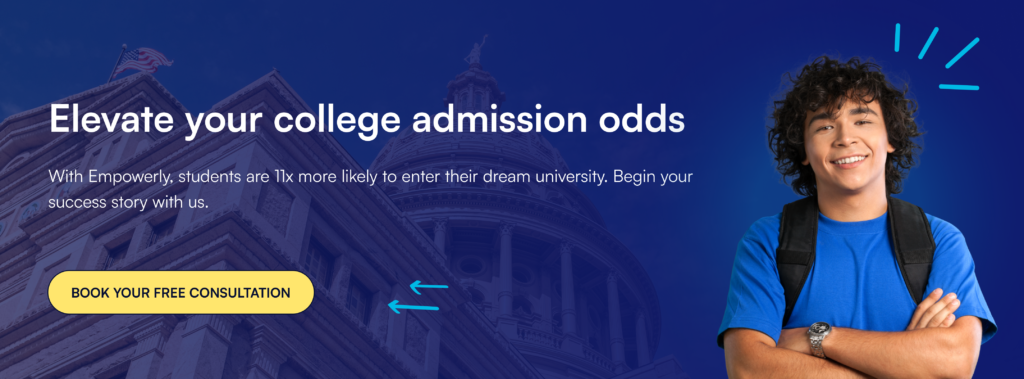You’ve heard the saying, “Look before you leap”?
Every year, thousands of high school students hit submit on Early Decision (ED) applications — often believing it’s just an early way to get answers. But this admissions option is more than just a head start. It’s a binding commitment to attend if you are accepted.
Yes, Early Decision can be a strategic advantage in a competitive college landscape. But it can also be a trap for students who rush in unprepared, unaware of the implications for financial aid, college choice, and even personal ethics. That’s why understanding the binding truth behind Early Decision is essential — before you apply.
Entering a contract with a college is a high-stakes agreement. But just because your friends are jumping off a cliff doesn’t mean it’s meant for you! So let’s take a closer look at this important leap and where you might land.
What exactly is Early Decision?
Early Decision is a college application plan that allows students to apply earlier than the traditional Regular Decision deadline. But unlike other options, there’s a critical catch: if you’re accepted, you agree to enroll. This is what makes it binding.
When you apply Early Decision, you’re making a formal agreement with that college. If they offer you admission, you must:
- Withdraw all your other college applications,
- Decline any other offers you receive, and
- Commit to attending that school the following fall, as long as the financial aid package meets your needs.
Most Early Decision deadlines fall in early November, and students typically receive an answer by mid-December. This early timeline appeals to applicants who are certain about their first-choice school and want to reduce the uncertainty of waiting.
It’s important to note that Early Decision is not the same as Early Action. While both options offer earlier application deadlines and faster decisions, Early Action is non-binding. You can apply to multiple schools through Early Action and still wait to make your final college choice in the spring. Early Decision, by contrast, is exclusive: you can only apply ED to one college, and if admitted, you’re expected to follow through.
Some colleges also offer Early Decision II — a second-round option with a January deadline. This allows students to apply with the same binding agreement but gives them more time to polish their application or make their final decision about where they truly want to commit.
Empowerly Tip: If you’re even slightly unsure about your top-choice school — or need to compare financial aid packages — Early Decision might not be the right fit. Talk with a counselor to weigh your options.
Got all that? Here’s a quick recap:
| Feature | Early Decision (ED) timeline |
| Deadline | Typically November 1 |
| Binding? | Yes |
| # of Colleges Allowed | Only 1 ED allowed |
| Early Decision II Allowed | Yes, January deadline |
| Financial aid considerations? | Must enroll if aid is reasonable |
Why is Early Decision important in college applications?
For students who’ve done their research and feel confident in their top-choice school, Early Decision can offer a powerful strategic edge in the admissions process.
Here’s why: many colleges admit a significantly higher percentage of Early Decision applicants compared to Regular Decision applicants. It’s not because those applicants are automatically stronger — it’s because they’ve demonstrated an unequivocal commitment.
Colleges care deeply about their yield rate, which is the percentage of accepted students who actually enroll. A strong yield rate signals popularity and prestige, and it plays a role in national rankings. When a student applies Early Decision, they’re making a promise to enroll if accepted — so admissions officers are more confident in counting them toward that yield. In other words, ED applicants help colleges manage enrollment more predictably.
That’s why schools often reward that commitment with higher admission rates, especially for qualified students whose academic records match the school’s profile.
Of course, submitting your application early isn’t enough on its own. You still need to bring your A-game: strong grades, test scores (if applicable), compelling essays, and evidence of character and fit. But if you’re a strong match, Early Decision can increase your odds in a way that Regular Decision simply doesn’t.
However, this added edge only matters if the school is truly your first choice. Because of the binding nature of the agreement, there’s no backing out simply because you changed your mind or got a better offer somewhere else.
Already confused? Need a summary? Here’s the short version.
Benefits of Early Decision (+):
- Higher acceptance rates at many schools
- Early notifications reduce stress
- Strong demonstration of interest
Risks of Early Decision (-):
- Limited financial aid comparison
- Binding agreement (ethical implications)
- Less time to finalize application materials
What are the potential consequences of backing out?
Here’s the uncomfortable truth: backing out of an Early Decision agreement is possible, but not without consequences.
While Early Decision is not legally binding in the way a signed contract might be in court, it is considered ethically binding. When you apply ED, you, your family, and your school counselor all sign an agreement that commits you to enroll if accepted. Colleges take this commitment seriously — and they expect you to honor it.
So what happens if you change your mind?
In rare and legitimate cases, students are allowed to break their Early Decision agreement. The most common reason is financial hardship. If your family cannot afford the cost of attendance, even after aid or scholarships, you can request to be released from your commitment. This is often handled through communication between your high school counselor and the college’s admissions office.
But backing out for any other reason — like getting accepted somewhere else, second thoughts, or changes in interest — can reflect poorly on you. And it doesn’t just affect your relationship with that one college.
Here are some of the potential consequences:
- Your high school may be notified. The college may inform your counselor or administration that you’ve violated the ED agreement.
- Other colleges might find out. Some colleges share applicant information through systems like the Common App. Breaking an ED agreement could raise red flags at other institutions.
- Your admissions offers could be jeopardized. In extreme cases, a college could revoke its offer or decline to release you, though this is rare.
- It can impact future applicants from your high school. Colleges may become more hesitant to admit ED applicants from your school if they feel past agreements haven’t been respected.
The bottom line? Don’t apply Early Decision unless you’re absolutely confident that the school is your top choice and that the financial cost will be manageable. If you’re hesitating even a little, it’s a sign you may want to wait.
Before you go, let’s set a few more things straight…
Common ED myths
- “It’s legally binding.” False: It’s ethically, not legally, binding.
- “I can back out for any justifiable reason.” False: Only financial hardship is an acceptable reason.
- “It’s the only way to show interest.” False: Other demonstrated interest tactics exist.
- “Everyone should apply early for better odds.” False: Only if it’s truly your top choice.

Which colleges offer Early Decision?
Keep in mind that college admissions policies, including ED availability and deadlines, can change annually. Official information for the 2025-2026 cycle is typically released by colleges themselves during the summer and fall of 2025.
Here’s a comprehensive list of U.S. colleges and universities that offer Early Decision (ED) options, including both ED I and ED II where applicable. This information is based on the most recent data available for the 2024–2025 admissions cycle.
Some of the most famous and competitive colleges that offer the ED cycle include household names like the University of Pennsylvania, Columbia, Duke, Northwestern, Brown, Emory, and Vanderbilt. The following are organized alphabetically by state:
Alabama
- Birmingham-Southern College
Arizona
- Prescott College
California
- California Institute of Technology (Caltech)
- Claremont McKenna College
- Harvey Mudd College
- Occidental College
- Pitzer College
- Pomona College
- Santa Clara University
- Scripps College
- University of San Francisco
Colorado
- Colorado College
Connecticut
- Connecticut College
- Fairfield University
- Trinity College
- Wesleyan University
DC – District of Columbia
- American University
- Catholic University of America
- George Washington University
Florida
- Flagler College
- Florida Southern College
- Rollins College
- University of Miami
Georgia
- Agnes Scott College
- Emory University
- Morehouse College
- Spelman College
Illinois
- Augustana College
- DePaul University
- Knox College
- Lake Forest College
- Northwestern University
Indiana
- DePauw University
- Earlham College
- Rose-Hulman Institute of Technology
Iowa
- Grinnell College
Kentucky
- Centre College
Louisiana
- Centenary College of Louisiana
- Tulane University
Maine
- Bates College
- Bowdoin College
- Colby College
Maryland
- Goucher College
- Johns Hopkins University
- Loyola University Maryland
- St. John’s College (Annapolis)
- Washington College
Massachusetts
- Amherst College
- Babson College
- Bard College at Simon’s Rock
- Bentley University
- Boston College
- Boston University
- Brandeis University
- Clark University
- College of the Holy Cross
- Emerson College
- Hampshire College
- Harvard University
- Mount Holyoke College
- Northeastern University
- Smith College
- Stonehill College
- Tufts University
- Wellesley College
- Wheaton College
- Williams College
Michigan
- Kalamazoo College
Minnesota
- Carleton College
- Macalester College
- St. Olaf College
Missouri
- Saint Louis University
- Washington University in St. Louis
NH – New Hampshire
- Dartmouth College
NJ – New Jersey
- Drew University
- Princeton University
- Stevens Institute of Technology
NY – New York
- Bard College
- Barnard College
- Colgate University
- Columbia University
- Cornell University
- Hamilton College
- Hobart and William Smith Colleges
- New York University
- Rensselaer Polytechnic Institute
- Sarah Lawrence College
- Skidmore College
- St. Lawrence University
- Syracuse University
- Union College
- University of Rochester
- Vassar College
NC – North Carolina
- Davidson College
- Duke University
- Elon University
- Wake Forest University
Ohio
- Case Western Reserve University
- Denison University
- Kenyon College
- Oberlin College
Oregon
- Lewis & Clark College
- Reed College
- Willamette University
Pennsylvania
- Bryn Mawr College
- Bucknell University
- Carnegie Mellon University
- Dickinson College
- Franklin & Marshall College
- Gettysburg College
- Haverford College
- Lafayette College
- Lehigh University
- Muhlenberg College
- Swarthmore College
- University of Pennsylvania
- Ursinus College
- Villanova University
- Washington & Jefferson College
RI – Rhode Island
- Brown University
- Providence College
- Rhode Island School of Design
SC – South Carolina
- Furman University
- Wofford College
Tennessee
- Rhodes College
- Sewanee: The University of the South
- Vanderbilt University
Texas
- Rice University
- Southern Methodist University
- Southwestern University
- Trinity University
Vermont
- Bennington College
- Middlebury College
Virginia
- Hampden-Sydney College
- University of Richmond
- Washington and Lee University
Washington
- Whitman College
Wisconsin
- Beloit College
- Lawrence University
As you can see, this list includes a diverse range of institutions, from liberal arts colleges to major research universities, offering Early Decision options.

How to strategize: Should you apply early?
The decision to apply Early Decision shouldn’t be rushed. While it can increase your odds of acceptance at certain colleges, it’s not the right move for everyone. Let’s explore two key scenarios — when it makes sense to commit early, and when waiting might be the better path.
When ED is the right choice
Early Decision is a smart strategy if you’re confident in your top-choice school and meet several key criteria. Here’s what an ideal Early Decision applicant looks like:
- You have a clear first-choice college. You’ve researched thoroughly, visited (virtually or in person), and can confidently say, “This is where I want to be.”
- Your academic profile is strong and competitive. Your GPA, course rigor, and (if applicable) test scores align with or exceed the college’s typical admit range.
- You’re ready early. Your essays, recommendations, and application materials are polished by October.
- You don’t need to compare financial aid offers. Your family is either confident in your aid eligibility or willing to commit regardless of cost.
- You’re emotionally ready to commit. You understand the binding nature of the agreement and are excited, not anxious, about making that commitment.
Applying Early Decision in this case can show colleges you’re serious, focused, and proactive — qualities they value in future students.
When should you wait?
Early Decision might seem tempting, but it’s not always the best option. Here’s when applying Regular Decision makes more sense:
- You’re still finalizing your college list. If you’re uncertain about your top choice or want to visit more campuses, wait until you’re confident.
- You want to compare financial aid packages. ED applicants receive only one offer, while RD applicants can compare multiple offers.
- You need more time to improve your application. Maybe your fall grades, test scores, or essay drafts aren’t quite ready — use the extra time to strengthen them.
- You’re aiming for merit aid. Some colleges prioritize merit scholarships for Regular Decision applicants. Applying for ED can sometimes reduce your eligibility.
- You don’t want to commit yet. That’s valid. College is a major life decision, and you deserve to choose freely.
If you’re hesitating — even a little — listen to that instinct. Regular Decision gives you options, time, and control. The best strategy depends on your goals, your readiness, and your values. There’s no one-size-fits-all answer, but there is a right answer for you.
Sample ED timeline
Raring to go? Here is a sample timeline for what your early college preparation could look like when your senior year of high school rolls around.
- August–September: Finalize top-choice school, polish essays
- October: Request recommendations, finalize application materials
- Nov 1: Submit Early Decision application
- Dec: Receive ED decision
- Jan–Feb: Submit any remaining financial aid forms
And then, of course, in the spring semester comes the best part: finishing early!
Conclusion: choose carefully
Early Decision can feel like a shortcut to certainty in a long and stressful college admissions process. And for the right student, it absolutely can be a strategic advantage. But it’s also a serious commitment — not just a faster timeline. When you apply ED, you’re telling a college: I’m all in.
That’s why understanding what binding really means — legally, financially, and emotionally — is so important. It’s about more than just admissions rates or application deadlines. It’s about making the right decision for you.
If you’re clear on your dream school, financially prepared, and ready to commit, Early Decision might be your best path forward. If not, Regular Decision gives you the time and flexibility to compare options, improve your profile, and make a confident choice without pressure. The best college application strategy is one that’s informed, intentional, and tailored to your goals. Not someone else’s.
Still, need help deciding?
At Empowerly, our expert counselors work one-on-one with students to build application strategies that work. Join the 98% of students who have worked with Empowerly and been accepted into the Ivy League and top 25 schools. From choosing whether Early Decision fits your goals to strengthening your essays and navigating financial aid, we’re here to guide you every step of the way.
